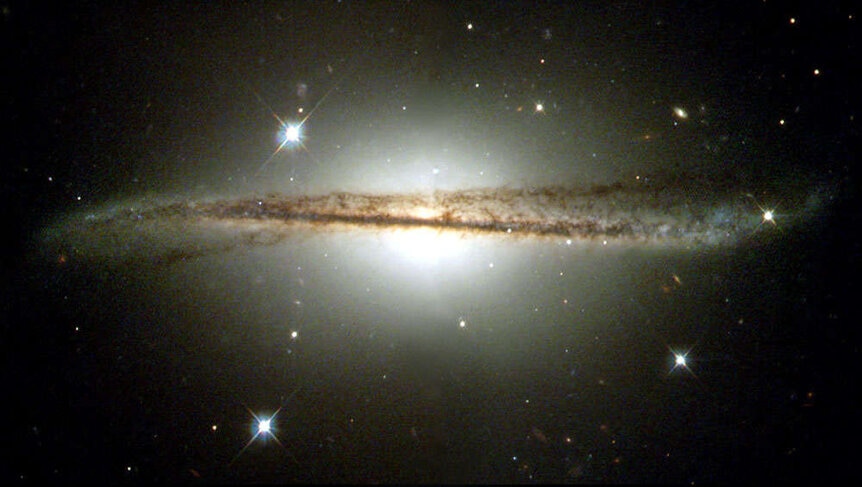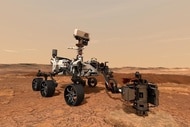Create a free profile to get unlimited access to exclusive videos, sweepstakes, and more!
We live in a warped galaxy, and it only gets weirder from there

In every image of the Milky Way you have probably ever seen, it seems to be a flat, serene swirl suspended in the darkness of space. You would probably never guess that another galaxy nearly ran into it 3 billion years ago.
Living in a warped galaxy sounds like existing in the Star Trek universe as opposed to this one, but science can back it up. It hasn’t exactly been a secret among astronomers and astrophysicists. Now, new research has gotten the closest look yet at the warp in the Milky Way. Astronomer Xinlun Cheng, of the University of Virginia, and his team now got a closer look with data from the Sloan Digital Sky Survey and Gaia, following the warp through different groups of stars. This revealed that this irregularity in our deceptively flat-looking spiral galaxy travels all the way around it every 440 million years.
Our galaxy was not always warped. It just happened that a satellite galaxy ventured too close, and that galaxy lured stars from the disc of the Milky Way towards it with its gravity, warping the gaseous disc and the arrangement of stars in the process. While we already know our galactic realm is anything but boring, it is also anything but flat. Think twisted.
“SDSS data has provided us with high precision velocities along the line of sight (measured through their Doppler effect) as well as detailed information on the chemical composition of stars,” Cheng, who recently led a study presented this week in a virtual meeting of the American Astronomical Society, told SYFY WIRE. “The Doppler velocities, when tied together with the other two dimensions of motion given to us by the Gaia satellite astrometry, allows us to know very precisely how the stars are moving in 3D space.”
Because Earth is stuck deep in the warp, Cheng and his team needed to make out what the shape of the twisted disc of the Milky Way looks like around us. Figuring out where a star is by using the Doppler effect involves finding out the frequency at which waves of light take off from that star. The difference between that and the frequency at which light reaches the observer will tell you about stellar movements that are going on. Because the difference between frequencies depends on how the source of light waves is moving in relation to the observer and vice versa, so there could be a slight margin for error, but probably not much.
SDSS observed spectra that gave away the chemical compositions of stars, which made it possible to put an age to them. You can gauge the approximate age of a star by finding out the amount of heavy elements in it. Depending on when a star forms, certain amounts of heavy elements are trapped in its atmosphere. Stars of varying ages react differently to the warp, or may not react at all, depending on when they were born. The ages of the stars revealed around when the warp could have happened, something Cheng wants to investigate in more detail as he studies this phenomenon further. 3 billion years is nothing in cosmic terms.
“Stars near each other experience similar gravitational potential, so they will have similar motions, but individual stars have a certain degree of freedom in motions,” he said. “When we average a large amount of stars within a small area, the difference in motions of individual stars will smear out and we will get the bulk motion of stars within that small region.”
Next to a more precise time for when the warp occurred, Cheng is also determined to shed more light on the intruding galaxy. At least half of spiral galaxies are warped in some way because of encounters like this. A galaxy cannot possibly exist for billions and billions of years without experiencing a close call with some gargantuan object, usually another galaxy with enough gravitational power to have a lasting effect on it. Rogue planets and passing asteroids aren’t going to have much of an impact on something that exceeds their mass so many times over.
Another mystery still hanging in space is what connection the warp in the stars could have to the warp in the gaseous disc that was previously seen through radio astronomy. How similar the 3D shapes of the gaseous and stellar warps are remains unknown. The problem with radio observations is that they are too limited. Unable to give any idea as to how far away the gas is, they make it nearly impossible to determine the shape of the disc.
“We know that the stellar warp and gas warp seem to be coincident in direction, but we do not know much more than that,” said Cheng. The other side of the warp is also mostly in the dark. It is hiding behind the dense bulge of the Milky Way, which is populated by swarms of stars that outshine whatever distant stars are floating around on the other side of the disc. Massive amounts of dust in the galactic bulge only make them appear fainter.
Just be glad that we will all be stardust by the time the galaxy Andromeda head-butts the Milky Way in another 4.6 billion years—you wouldn't want to be around for that.



























